Most Popular Fintech Trends to Expect in 2022 and Beyond

The fintech industry is growing rapidly with global funding increasing by 96% over the past year. The more technological innovations in this sector are evolving, the more fintech businesses are becoming “decacorns” (companies valued at more than $10 million.)
In addition, during pandemic times, most financial companies had to undergo a technological transformation. Users of financial services are gradually moving to the digital sphere preferring online services over traditional ones. This encourages finance companies to make quick decisions, integrate the latest technologies into their services, and constantly improve their customer services.
So, what fintech trends will shape the industry and influence the decision-making of the finance business in 2022 and beyond?
Let’s take a look at our predictions concerning the future technology trends of the fintech industry.
Read also: How to Build a Banking App in 2022
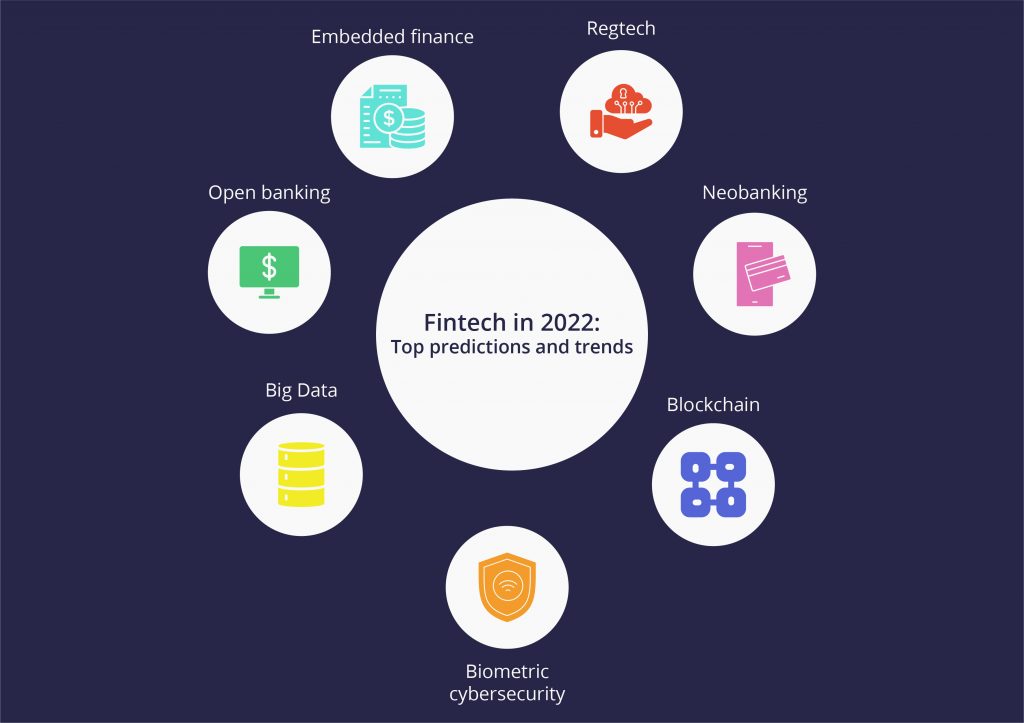
Emerging fintech trend #1 Digital-only banks or neobanks
Today competition among banks is increasing, making them look for new opportunities to stay afloat. The competition for each client, the need to reduce maintenance costs, and current technological opportunities have all given rise to the latest fintech trend – neobank. A neobank is an online bank that doesn’t have branches or physical representations. Communication and customer service are carried out electronically through smartphones, tablets, or personal computers. Neobanks usually receive banking licenses or work as a junior partner of an existing traditional bank.
There are currently about 70 neobanks globally, 40 of which are located in the UK. Moreover, Sweden will become the first country to stop using cash by 2023, and the rest are likely to follow this trend in the future. Thus, more and more new banks today are choosing a digital-only approach. The number of neobanks’ users will double from 2020 to 2024, according to an eMarketer report. Moreover, Galileo’s 2021 State of Consumer Banking and Money survey states that 62% of Americans are likely to use digital-only banks in 2022. Since even older generations are interacting more confidently with technology from year to year, the transition to digital banking is becoming almost inevitable in the future.
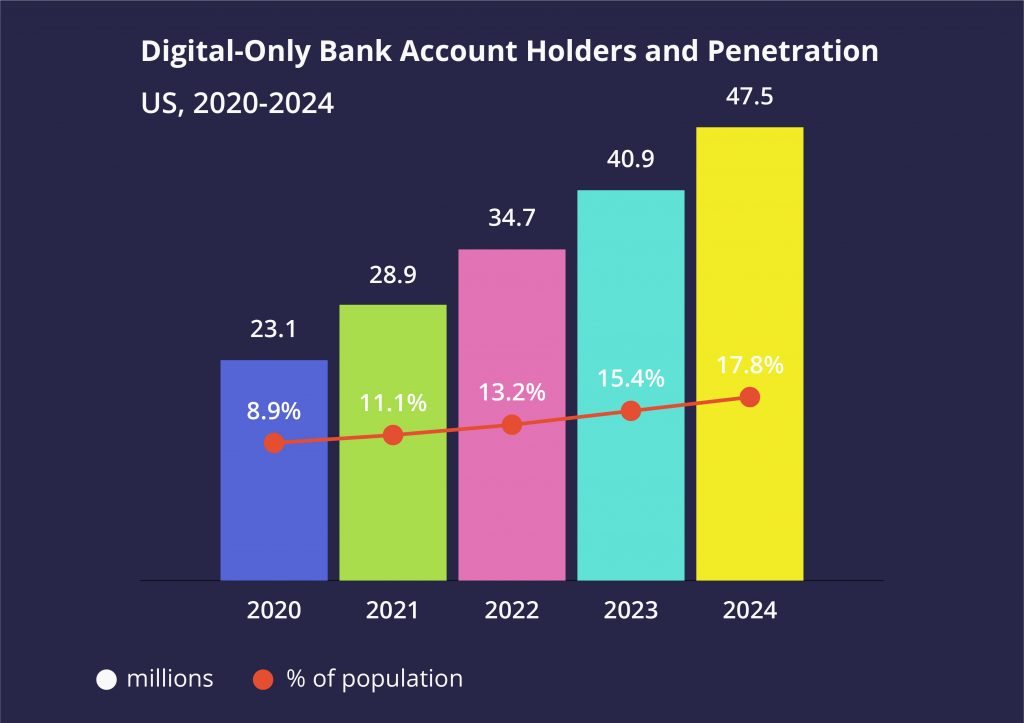
The most popular neobanks in the world today include Revolut, Monzo, Statrys, #26, Atom bank, Cleo, and others.
Wonder why they win the competition over traditional banks? Here are some answers:
- Low upfront costs. Neobanks don’t require significant investments for a start-up due to fewer regulatory requirements.
- Fast response time. Most clients’ requests are processed automatically to provide service within a few minutes.
- Better user experience. Clients receive services 24/7 from anywhere in the world.
- Simplified cryptocurrency integration.
- High automation.
- Competitive rates and lower fees
Upcoming fintech trend #2 Embedded finance
Embedded finance is a new fintech technology trend that will grow rapidly in 2022.
The idea of embedded finance is to integrate payments for loans, insurance, debit cards, and investment instruments with almost any non-financial platform. Embedded finance services are especially beneficial for e-commerce businesses since they facilitate the speed of transactions, therefore, helping increase customer loyalty. Previously, clients had to go to the bank for a loan, put in a request, pass an assessment procedure, and wait for the approval.
But today, with embedded finance, customers can get credit and purchase whatever they need in a few clicks on a store’s website. The forecast for this trend is impressive, especially for embedded payments.
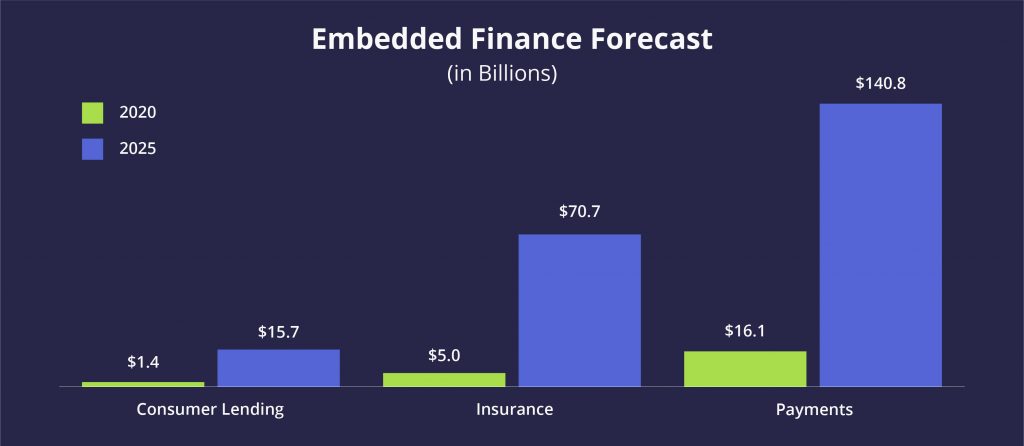
Embedded payments are used in various spheres. For example, today, users don’t have to pay in cash for their rides.
They can use ride-sharing apps like Lyft or Uber with embedded payment options. Or another example is the Starbucks coffee chain that allows customers to pay for orders directly from their app.
Embedded insurance is one more emerging trend. For instance, you don’t need to contact a broker to get insurance when you buy a Tesla car. This option is already embedded into a purchase.
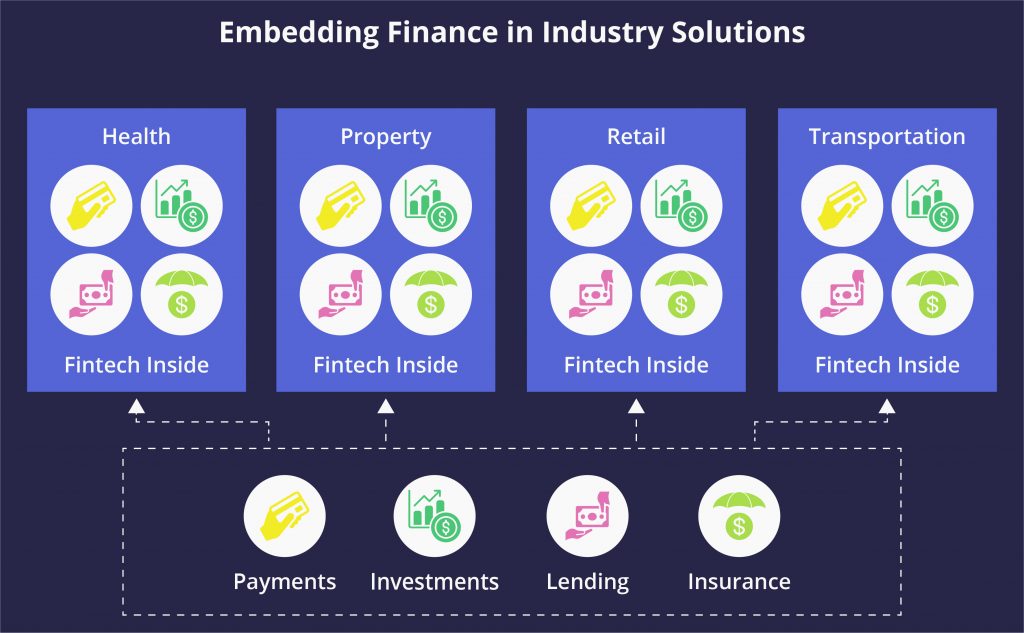
All of these embedded finance solutions will benefit fintech organizations and banks and at the same time encourage healthy competition in financial and other industries.
Trend #3 Open banking
McKinsey states that the number of open banking users doubled in 2020, so this trend is definitely worth paying attention to.
Open banking refers to an initiative by which banks can share clients’ data with fintech companies and other financial institutions. Data sharing can be done through programming interfaces (APIs) that give the site or app access to the bank’s database.
One may wonder why traditional banks would share their data with other institutions? Paradoxically, open banking helps banks stay competitive. This way, banks can provide better service and the widest opportunities to the end-user.
For example, open banking will allow you to create applications that contain all the financial information from different banks in one place. Users will be able to receive their salary on a card of one bank, save money in another, and pay with the bank’s card with the highest cashback reward. With the help of open banking, companies can implement an account aggregator. The users can access all their accounts through one convenient application (good examples are Tink and Plaid).
Financial institutions can also benefit from open banking.
For example, lenders can quickly assess the risks of lending to a client or personalize loan interest rates for them. Below you can see some interesting stats about open banking.
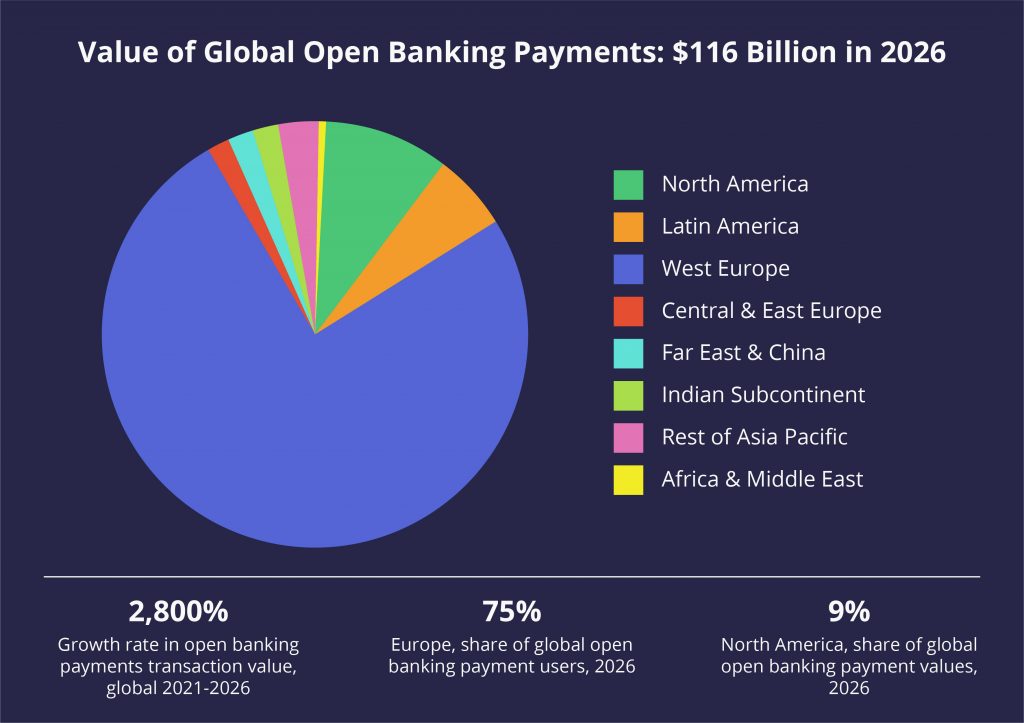
Trend #4 Blockchain technology
Blockchain is a relatively new technology trend in fintech with excellent prospects in years to come. Recently, Deloitte made a Global Blockchain Survey where 76 percent of survey participants said they believe digital assets might replace fiat money in the next 5-10 years. Blockchain technology allows companies to protect data, conduct verification and identification, register transactions, sign contracts, and enhance traceability. This technology is beneficial for financial services due to its safety and reliability.
The idea of decentralized finance has been discussed for many years. Today, financial systems operate centrally: banks and financial institutions act as intermediaries in the lending process and, if necessary, enforce the contract. But what will happen if we create a system in which everyone can freely use financial products without the mediation of banks and brokers?
In the coming years, fintech companies will build a new ecosystem that will change every financial sector: from stock trading to insurance. Supporters of decentralization insist that it will reduce the risks of large-scale financial crises because the finances of entire countries will no longer depend on a few large banks.
In theory, the blockchain should be the critical technology to creating such a system. The data stored through Blockchain can’t be changed or deleted, so it provides transparency, anonymity, and transaction security for all parties.
With at least $40 billion worth of assets held in cryptocurrencies and decentralized finance today, we all have seen explosive growth in the value of Ethereum and Bitcoin throughout 2021. It is already a global trend that impacts macroeconomics. Here are some statistics that indicate Blockchain is one of the top fintech trends for the future years.
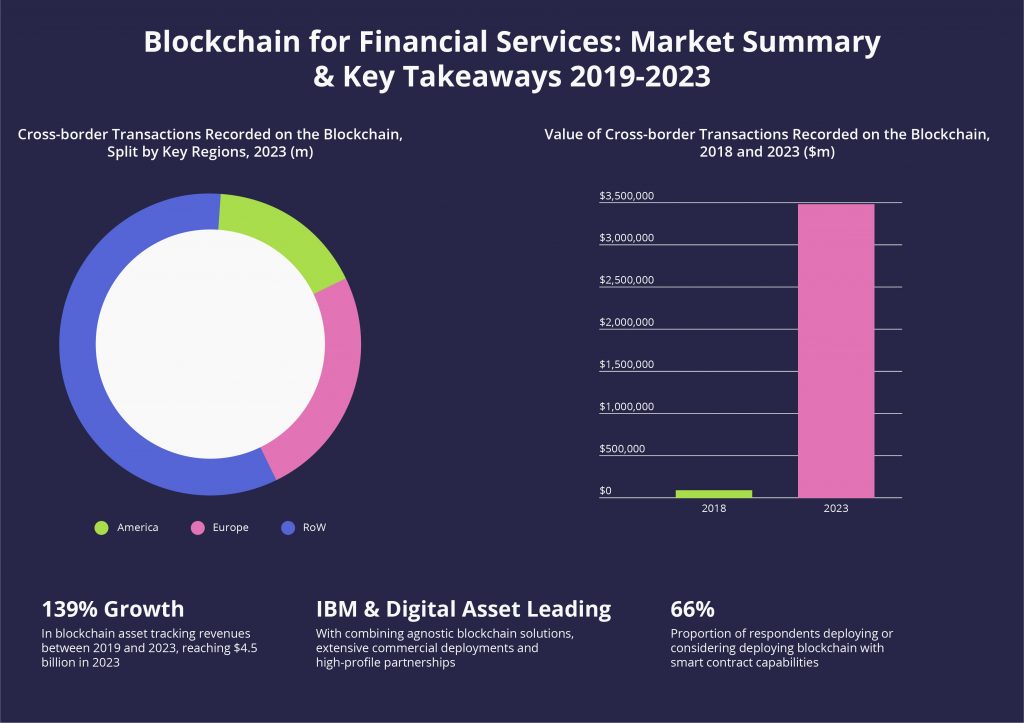
Trend #5 Big data
Speaking of the latest fintech trends, we can’t forget to mention Big Data. Big Data in finance refers to vast arrays of structured and unstructured data that banks and financial institutions can use to predict consumer behavior and develop strategies. Every second, the financial sector receives, processes, and generates huge amounts of data. Structured data is information stored internally within a company to provide key data for decision-making at the right time. Unstructured data is accumulated from various sources in an ever-increasing amount, providing significant analytical potential.
Modern financial technologies make it possible to use Big Data to predict customer behavior and create complex risk assessments, which distinguishes them from traditional financial institutions.
Here is how Big Data can benefit the finance world in 2022:
- Customer focus. Big Data allows companies to segment customers more accurately according to their profiles to provide optimal solutions.
- Data security. While fraud is a common problem in the digital banking sector, Big Data can help fintech develop accurate fraud detection systems by identifying suspicious activity.
- Risk assessment. Fintech companies can operate with greater financial confidence, manage cash flow, and offer consumers competitive fees through improved risk assessment.
- Improvement of user experience. Companies can identify customer needs and offer solutions faster and more accurately depending on user behavior.

Fintech Market Trend #6 Regtech
State bodies and financial markets put forward their requirements for banking organizations. There are so many of these rules that companies often struggle to comply. Thus, businesses spend huge sums on lawyers to manage this process or pay fines if they are not meeting the fintech regulations. Following every rule is impossible, especially when the list of these laws grows steadily. That’s why regtech is growing in demand today. It allows financial companies to track the correctness and legality of their operations automatically.
Regtech’s tasks include identifying clients, processing and protecting data, and analyzing financial risks. This helps to comply with legal regulations and avoid fines.

Due to automation, Big Data, and Machine Learning, regtech allows processing vast amounts of regulatory requirements every second in relation to each line of business. These automated solutions are programmed to constantly explore and look for historical data patterns. Thus, it becomes easier to identify problematic cases or detect fraud using regulatory technologies.
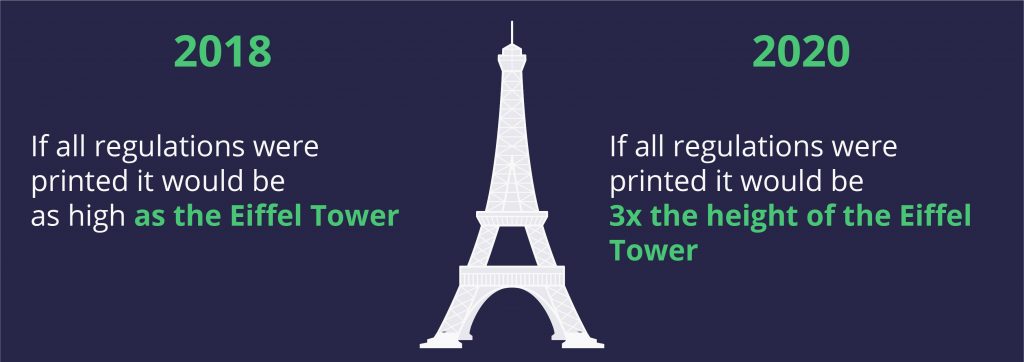
Trend #7 Advanced cybersecurity
Cybersecurity never loses its importance and becomes one of the main fintech market trends. Financial data is sensitive and extra vulnerable to cyber threats. A data breach can cost financial businesses a lot. Here are some stats:

Due to the increasing vulnerabilities and cyberattack risks in the fintech industry, advanced security measures will develop every year. The biometrics market size will reach almost $25 billion in the next few years, according to Grand View Research.
The COVID-19 pandemic is changing the way the world approaches information protection. Fingerprinting is one of the hottest technologies right now, but people are looking for new contactless ways to protect their data and recognize their identity. In 2022, systems for recognizing the voice, retina, ears, the pattern of veins on the hands, and even DNA will evolve. It’s expected that there will be a rise in industry-specific biometric solutions. For example, finance organizations now consider multifactor biometric authentication for mobile banking. With this type of authentication, mobile devices will identify the user by face and voice recognition at once. This will result in higher security and the inability to spoof a real user.
Summing up
The possibilities of fintech are endless as innovation is based on constantly evolving emerging technologies. Consumers want to receive better and more diverse financial services, and companies strive to cover these needs. Based on our in-depth experience in fintech product development, we can say confidently that following the fintech trends and incorporating the technology in your business is vital to staying afloat.
At Alternative-spaces, we help develop investment management solutions, card and payment systems, digital and mobile banking products, financial and payment services apps, and web/mobile app development for financial institutions.
We believe that employing innovative technologies like blockchain, artificial intelligence, machine learning, and robotic process automation is essential for banks, lenders, and startups to prosper and thrive. Being up-to-date helps organizations provide a great customer experience, reduce costs, automate routine tasks, and ensure high data protection.
If you’re looking for a professional development team to integrate fintech trends and grow your business, just drop us a line. We’re here to help.
Content created by our partner, Onix-systems.
Source: https://onix-systems.com/blog/most-popular-fintech-trends Home
Home